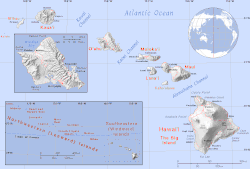| Laysan finch | |
|---|---|
 | |
| Scientific classification | |
| Kingdom: | Animalia |
| Phylum: | Chordata |
| Class: | Aves |
| Order: | Passeriformes |
| Family: | Fringillidae |
| Subfamily: | Carduelinae |
| Genus: | Telespiza |
| Species: | T. cantans |
| Binomial name | |
| Telespiza cantans Wilson, SB, 1890 | |
 | |
| Map of Hawaii showing Laysan in the lower left inset box | |
The Laysan finch (Telespiza cantans) is a species of Hawaiian honeycreeper, that is endemic to the Northwestern Hawaiian Islands. It is one of four remaining finch-billed Hawaiian honeycreepers and is closely related to the smaller Nihoa finch. The Laysan finch is named for Laysan, the island to which it was endemic on its discovery. It was subsequently introduced to a few other atolls, and its historical range included some of the main islands.




